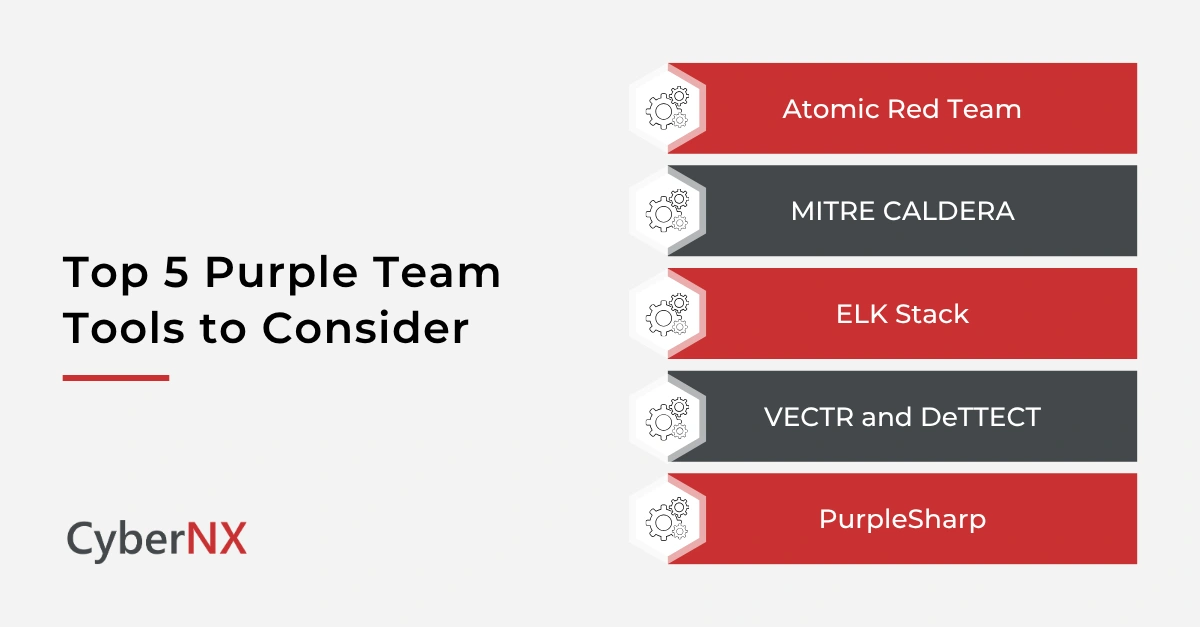Security teams today know that detection and defence are only as strong as the collaboration behind them. The best results happen when offensive and defensive experts share insights, test assumptions and close detection gaps together.
That’s the purpose of Purple Team Tools. They combine red-team creativity with blue-team rigour – helping organisations validate controls, tune detections and measure improvements. For CISOs and IT Heads, these tools turn fragmented testing into a repeatable, measurable and business-aligned exercise.
What are Purple Team Tools?
“Purple teaming” refers to the collaborative mindset that brings together the activities of the red team (attack simulation) and the blue team (defence, detection, response).
Purple team tools are technology platforms, frameworks, or scripts that support this collaboration. They may automate attack scenarios, track detection gaps, manage feedback loops, visualise attack paths, or orchestrate continuous exercises.
For example, a good purple tool may allow your red team to launch simulated tactics based on the MITRE ATT&CK framework and let your blue team review logs, validate alerts, and collaborate in real time.
These tools help surface visibility gaps, improve detection tuning, align security controls and turn the “find it and patch it” model into a continuous learning loop.
According to SANS Institute, continuous purple teaming strengthens both offensive testing and defensive maturity faster than traditional, isolated testing models.
Why investing in purple team tools matters
Here are some key reasons leaders should prioritise them:
- Faster gap identification: Tools designed for purple teaming help reveal which attack methods evade your detection stack.
- Better collaboration across teams: When red and blue teams share platforms and workflows, silos shrink, accountability rises.
- Optimised security stack ROI: These tools help you measure which controls are working, which aren’t, and therefore where investment yields returns.
- Continuous validation of defences: Rather than a one-off pen test, you can keep validating controls as your infrastructure evolves.
Top purple team tools to consider
Here is a curated list of standout tools, with key features and observations.
1. Atomic Red Team
A community-driven library of small, atomic tests that simulate adversary techniques defined in MITRE ATT&CK. Each test runs independently to validate a specific control.
Key Features:
- Ideal for verifying whether EDR or SIEM alerts trigger correctly.
- Easy to automate and share between red and blue teams.
- Supports quick validation after new rule deployments.
Atomic tests are lightweight. Pair them with orchestration tools for large-scale or continuous simulations.
2. MITRE CALDERA
An open-source adversary emulation platform developed by MITRE. CALDERA automates attack chains to evaluate detection and response capabilities.
Key Features:
- Uses agents and plug-ins to run complex multi-stage scenarios.
- Integrates directly with the MITRE ATT&CK framework.
- Offers visual campaign tracking for red and blue teams.
Teams can simulate credential dumping or lateral movement and instantly check how detection rules performed. CALDERA suits mature teams comfortable with scripting and automation. It’s ideal for scaling purple teaming across multiple environments.
3. ELK Stack (Elasticsearch, Logstash and Kibana)
A popular open-source analytics stack used to collect, parse and visualise security logs. While not a traditional purple team tool, it’s essential for data analysis and visibility validation.
Key Features:
- Aggregates red-team telemetry and blue-team detection data in one view.
- Enables real-time dashboards for attack vs. detection mapping.
- Helps teams verify whether simulated attacks generated expected logs.
After running Atomic Red Team or CALDERA scenarios, use ELK dashboards to confirm detection coverage and identify missing telemetry.
4. VECTR and DeTTECT
Two open-source tools often deployed together for detection-gap analysis and visibility tracking. VECTR manages purple team campaigns, aligning them to MITRE ATT&CK. DeTTECT measures how well your environment detects or logs each tactic.
Key Features:
- Provide central dashboards showing which attacks were detected, missed or partially logged.
- Simplify evidence sharing between red and blue teams.
- Support structured reporting and progress tracking over time.
5. PurpleSharp
A Windows-focused attack simulation tool designed for detection engineering and purple team collaboration.
Key Features:
- Generates realistic attack telemetry using .NET executables.
- Helps blue teams validate EDR alerts and log sources.
- Simple to integrate with pipelines for repeat testing.
Requires administrative permissions to run safely in test environments. Use isolated labs or sandboxed domains.
These tools require good telemetry and disciplined process management. When implemented well, they offer a transparent way to show security maturity improvements.
The curated list from the GitHub repository “Purple-Team-Resources” offers many more tools and links for both red and blue activities. Other generic frameworks like agent-based simulation tools, logging analytics platforms and custom detection dashboards are often part of the toolset.
How to pick the right purple team tools
Selecting tools is less about ticking boxes and more about fit, process and outcomes. Here’s what to evaluate:
1. Align tool capabilities with your maturity
If you’re just starting purple teaming, pick tools that help you visualise detection gaps and track campaign metrics rather than heavy automation. If your SOC is mature, lean toward continuous simulation, metrics, and control validation.
2. Coverage of adversary techniques
Ensure the tool maps to frameworks like MITRE ATT&CK so you can test meaningful scenarios – not just trivial ones. Coverage across host, network, identity, application layers is important.
3. Collaboration and workflow support
Since purple teaming is about red + blue working together, tool features like shared dashboards, feedback loops, alerts for detection missed, and clear remediation workflows matter a lot.
4. Integration with your existing security stack
Your tool should plug into SIEM, EDR, logging pipelines and ideally output actionable insights (not just raw data). If it’s isolated, the value drops.
5. Measurable outcomes
Look for tools that let you define KPIs (detection coverages, time to detect, gap counts) and track improvement over time.
Start with a minimum viable purple team toolset. Focus on one business-critical attack path, run a simulation, use the tool to capture gaps, then iterate. Small successes build momentum.
Key Purple Teaming Trends
While you research and finalize tools, it is important to keep an eye on the latest trends and where the cybersecurity landscape is heading.
- Automation of purple teaming: More tools now support scheduled or continuous adversary emulation rather than one-off events.
- Focus on detection engineering: Tools are shifting from just “simulate attack” to “how quickly did your detection fire? what logs missed it?” – deeper analytics.
- Cloud and Identity-first scenarios: As more infrastructure shifts to cloud and identity becomes the new perimeter, purple team tools will need to cover those layers.
- Bridging to business metrics: Decision-makers want to see how purple team results tie to risk, cost, compliance. Tools offering dashboards for executives will differentiate.
Conclusion
Choosing the right purple team tools matters if you want to elevate your security maturity. It’s not about buying a tool and forgetting it. It is equally important to embed the process, run effective campaigns, interpret findings through a business lens and improve your defences over time.
If you’re ready to take the next step, contact us today. Let’s assess your current toolset, identify gaps and recommend the right purple team platform for your needs.
Purple team tools FAQs
Do I need a dedicated ‘purple team’ tool if I already have red- and blue-team tools?
Not always. If your red and blue teams share process, workflow and metrics, you may already be doing “purple team” work. But a dedicated tool helps scale, track campaigns and visualise gaps.
How often should we run purple team simulations using these tools?
It depends on your risk-profile, infrastructure change rate and regulations. But many organisations benefit from at least quarterly campaigns, and if the tooling allows continuous simulation, monthly or even weekly.
Are open-source tools sufficient for purple teaming?
Open-source tools (like VECTR, DeTTECT) provide great value, especially for smaller teams. But for full enterprise scale, commercial tools may offer easier integration, richer dashboards and vendor support.
What key metric should I track when using purple team tools?
Detection coverage of highest-risk attack paths, time to detect/respond, number of gaps remediated, and trends in false positives. Metrics should tie back to business risk and security posture over time.






